
| Palaeos |  |
Squamata |
| The Vertebrates | 350: Scleroglossa: Scincomorpha |
| Page Back | Unit Home | Unit Dendrogram | Unit References | Taxon Index | Page Next |
| Unit Back | Vertebrates Home | Vertebrate Dendrograms | Vertebrate References | Glossary | Unit Next |
|
Abbreviated Dendrogram
SQUAMATA | Scleroglossa |--+--Gekkota | |--Dibamidae | `--Autarchoglossa/Scincomorpha (paraphyletic according to molecular phylogeny) | |--+--Paramacellodidae | | `--+--Scincidae | | `--Cordyloidea | |--Xantusiidae | `--+--Lacertiformes | | |--+--Teiioidea | | | |--Teiidae | | | `--Gymnophthalmidae | | `--Boreoteiioidea | | |--Polyglyphanodontinae | | `--Gilmoreteiidae | `--+--+--Lacertidae | | `--Amphisbaena (according to molecular phylogeny) | `--+--Anguimorpha | | |--Anguoidea | | `--Varanoidea | |--Iguania (according to molecular phylogeny) | `--Pythonomorpha `--Iguania (according to gross morphology) |
Contents
Overview |
.jpg) |
| Bronze Mabuya or Bronze Grass Skink- Eutropis macularia (family Scincidae)Andhra Pradesh, India. photo J.M.Garg, Wikipedia |
The Scincomorphs are similar to and in morphological studies considered the sister group to the Anguimorphs (Estes et al 1988), but in molecular phylogeny they become a paraphyletic grade, or alternatively a number of smaller clades (Hedges & Vidal 2009). This latter arrangement is followed here, and Scincomorpha sensu lato are divided into Scincoidea/Scincomorpha and Lacertiformes, while a third group, Xantusiidae , could go with either. In both Scincomorphs (traditional morphological definition) and Anguimorphs there is a tendency for the body to become elongated and the limbd to be reduced (it is easy also to see how this can lead to the evolution of snakes). Many also have devoped armoured scales (osteoscutes) that cover the head and trunk (Carroll 1988 p.617). Both groups appear during the middle to late Jurassic, and become particularily diverse and successful during the late Cretaceous. During the early or mid Cretaceous the Lacertiformes gave rise the to a very successive and diverse clade of highly specialised forms: the herbivorous terrestrial Boreoteiioids, and from a basal Anguimorph origin there developed the Pythonomorpha. This latter group includes both the giant marine carnivorous mosasaurs and the highly successful snakes. If some molecular phylogenies are to believed, than the Iguanians share a common origin with anguimorphs and snakes, making up the Toxicofera clade (all sharing unique venom glands). As appealing as this hypothesis is, it is hard to believe that specialised ancestors could undergo so many morphological reversals to become such generalised and primitive descendents (see discussion on Iguania and Scleroglossa), and it is perhaps more likely that venom glands evolved twice. Even so, like all hypotheses, this one should not be rejected out of hand.
Scincomorphs, Lacertiformes, and Anguimorphs each have a rich is somewhat patchy fossil record. Scincomorphs sensu lato dominate most Laurasian lizard assemblages in the Mesozoic, but there is insufficient data to determine their pattern in Gondwana. Most early taxa are based on fragmentary remains, usually jaws, and cannot be further classified with certainity. Many Jurassic records belong to the early and very successful group Paramacellodidae, and extant scincomorph (Scincoidea and Lacertiformes) groups are not known with certainty until the late Cretaceous. (Evans 2003 pp.525-6 ). MAK101106
 Scincomorpha: skinks and their relatives.
Scincomorpha: skinks and their relatives.
Definition: All taxa sharing a more recent common ancestor with Scincus scincus than with Gekko gecko, Anguis fragilis, or Varanus varius. Conrad, 2008 p.98
Range: from the Middle Jurassic.
Phylogeny: Autarchoglossa :Lacertiformes (morphology)/Episquamata (molocules) + Xantusiidae + * : Paramacellodidae + Scincoidea
Characters: Pleurodont; dorsal temporal arch is usually present; parietals fused; tongue simple; heads not clearly demarcated from body; six cervical vertebrae; slim bodies; fewer than four rows of transverse belly scales per body segment. Common: limb reduction and elongation, osteoscutes on head & trunk, upper fenestra filled in, simple, kinetic frontal-parietal articulation, pineal opening on suture.
Comments:Estes et al 1988 definition (morphologically, and also as sister group of Anguimorpha) is paraphyletic according to molecular phylogeny (Vidal & Hedges 2005, Hedges & Vidal 2009), and hence equivalent to basal Autarchoglossa. In this case the above characters also apply to basal Episquamata. To avoid paraphyly, Hedges & Vidal 2009 use a more restricted definition of Cordylidae + Scincidae. Conrad, 2008's phylocode style definition and use of anchor taxa gives a broader stem based definition. If a morphological definition is preferred over a molecular one, than the Lacertoidea/Lacertiformes and Cordyloidea, and possibly also the Amphisbaena, are included under a monophyletic Scincomorpha. Conrad, 2008 pp.98-9Links: Scincomorpha; BuchstabeS (German); The EMBL Reptile Database. ATW021203, amended MAK101106.
 |
| Paramacellodus oweni Hoffstetter, 1967, left lower jaw in lateral and medial views. From Fossil Reptiles of Great Britain from Estes 1983 |
Range: Middle Jurassic (Late Bathonian) to Early Cretaceous of Europe, North America, Tanzania, China and Japan
Phylogeny: Scincomorpha :Paramacellodidae + Scincoidea
Comments: A predominately Laurasian group of small to medium-sized scincomorphs with a covering of rectangular bony plates (osteoderms), similar to those of some living cordyliforms, with which they have been associated. (Evans 2003 pp.525-6) and which they doubtless resembled in life. The peg-like teeth of the tiny Paramacellodus (right) suggest an insectoivorous diet (Benton 2000 p.239) MAK101103
Range: Middle Jurassic to Recent, Cosmopolitan
Phylogeny: Scincomorpha :Paramacellodidae + * : Cordyloidea + Scincidae
Comments: Estes et al 1988 defined this as node-based taxon as "the most recent common ancestor of Scincidae and Cordylidae and all of its descendants" and list 16 synapomorphies, making this a well-defined clade. The Mesozoic stem-group Paramacellodidae has often been associated with the Cordylidae, and may also belong in this clade, but for now is considered separately.
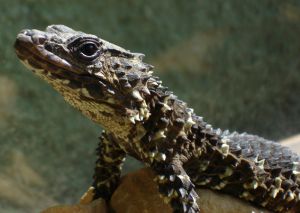 Cordyloidea: Cordylidae and Gerrhosauridae
.
Cordyloidea: Cordylidae and Gerrhosauridae
.
Range: Eocene of Europe, Miocene to Recent of Africa
Phylogeny: Scincoidea :Scincidae + *
Comments: medium sized lizards that inhabit arid and semi-arid regions in Madagascar and eastern Africa. They have flattened heads and bodies, and are distinguished by a heavy armour of osteoderms and large, rectangular, scales, arranged in regular rows or spines around the body and tail. Among some general there is a tendency to reduced or loss of limbs. Two families are distinguished: Cordylidae, (Spinytail lizards or Girdle-tailed lizards) and Gerrhosauridae (plated lizards, photo), although Carroll 1988 p.617 synonymises the two. Hedges & Vidal 2009 suggest the superfamily Cordyloidea.
Links (and image): Wikipedia Wikipedia
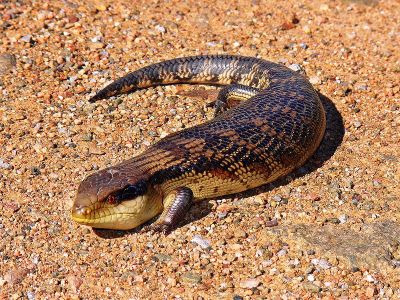 |
| Eastern Blue-tongued Lizard (Tiliqua scincoides scincoides), Eastern Australia, photo by Benjamint444, Creative Commons, Wikipedia Wikipedia |
Range: Late Cretaceous to Recent, Cosmopolitan
Phylogeny: Scincoidea :Cordyloidea + *
Comments: The second largest of the lizard families (after the geckos) with about 1200 species. The legs tend to be small, reduced, or in a few cases even absent (e.g., Typhlosaurus. The form of movement may also be snake-like.
Links: Wikipedia
Xantusiidae: Night lizards.
Range: Middle Paleocene to Recent of North and Central America
Phylogeny: Autarchoglossa :Lacertiformes (morphology)/Episquamata (molocules) + Scincomorpha + *
Comments: An small enigmatic group of very small (about 4 cm to 12 cm), viviparous (live-bearing), omnivorous lizards. There are only three genera and about 23 extant species.. Depsite their common name, they are not nocturnal. Their phylogenetic position is uncertain. Conventionally they are included in the Scincomorpha (morphological definition) (e. g. Camp, 1923; Romer, 1956; Estes, 1983, Carroll 1988 p.617)), but other studies suggest gekkotan affinities, and Lee 1998 united them with gekkos, dibamids, and amphisbaenians in a new clade, Nyctisauria, as the sister group of other scleroglossans. Estes, 1983 placed them as the sister group to the scincids and cordylids, but in a revised study Estes et al 1988 found they share a greater number of derived characters with the Lacertiformes. Using molecular phylogeny Hedges & Vidal 2009 return the Xantusiids to the scincid-cordylid clade, which they call Scinciformata. In view of all this confusion, i've placed the Xantusiidae between the Scincoidea and Lacertiformes, recognising they could belong to either group, although if the findings of molecular phylogeny are correct and the Scincomorpha in the traditional definition are paraphyletic it probably doesn't matter that much . MAK101104
Links: Wikipedia
Range: Middle Jurassic to Recent, Cosmopolitan
Phylogeny: Autarchoglossa :Scincomorpha + Xantusiidae + * : Lacertiformes + Toxicofera
Comments: A clade that appears in molecular phylogeny, further develops Unidentatan vomeronasal prey discrimination, have deeply bifurcated tongues, the most developed Jacobson's organs and the highest metabolic rates among the squamata (Vidal & Hedges 2005). Implies a paraphyletic Scincomorpha, in that the Lacertiformes are included in the traditional Scincomorpha, whereas the Toxicofera is a new clade that groups Anguimorpha, snakes, and, most controversially and perhaps dubiously the Iguania, in a single higher taxon. However not all molecular phylogenies support this classification (Albertetal2009).
Lacertiformes (Laterata).
Definition:The most recent common ancestor of lacertids, teiids, and gymnophthalmids and all of its descendants. (Estes et al 1988)
Range: Late Cretaceous to Recent, Europe, Africa, Asia, North & South America
Phylogeny: Scincomorpha : Scincoidea + (Xantusiidae + * : Teiioiformes + Lacertidae) (following morphological arrangement of Estes et al 1988) or
Episquamata :Toxicofera + * : Teiioiformes + (Lacertidae + Amphisbaena) (following molocular phylogeny of Hedges & Vidal 2009)
Characters: Step or offset in tooth margin of maxilla and 14 other synapomorphies (Estes et al 1988) , lateral tile-like ventral (belly) scales (Vidal & Hedges 2005). See also Scincomorpha
Comments: Recognition of the relationship between lacertids and teiids (including gymnophthalmids) was accepted by Camp 1923 and many succesive authors. The clade appears to be one of the most stable within squamates (Estes et al 1988). An equivalent clade, Laterata, is identified by molecular phylogeny of Hedges & Vidal 2005 & Hedges & Vidal 2009, who however include the amphisbaenians. If the latter are included then they have lost typical Lacertiform characteristics, which is not unlikely given their specialised lifestyle. I have followed this convention here but retained the older name. As defined here, and as an attempot at synthesis of the morphological and molecular approaches and their contradictory phylogenies, the Lacertiformes are the sister group of the Anguimorpha + Pythonomorpha MAK101105
 |
| The western whiptail, Aspidoscelis tigris of the southwestern United States, a representative of the family Teiidae. Photo by Tigerhawkvok, Wikipedia. Although contemporary Teiioids are only about a quarter or so as diverse in terms of species as skinks, and less geographically wide-ranging, this was not the case in the past, when during the late Cretaceous the Boreoteiioids constituted an important and diverse clade of herbivours and omnivorous lizards with an efficient feeding apparatus. |
"Teiioiformes" (new name): Teiioidea of Estes et al 1988 plus associated Cretaceous forms.
Definition:The most recent common ancestor of teiids, gymnophthalmids, and boreoteiioids, and all of its descendants.
Range: Late Cretaceous to Recent, Europe, Africa, Asia, North & South America
Characters: Retain (or reversal of loss of) the dorsal process of the squamosal, a primotive feature found otherwise only in the Iguanians and more basal lepidosaurs (Carroll 1988 p.231).. In other respects however they are more specialised (Estes et al 1988)
Phylogeny: Lacertiformes :(Lacertidae + Amphisbaena) + * : Boreoteiioidea + Teiioidea
Comments: Common and diverse in the Late Cretaceous of Central Asia and North America. Today known only from Central and South America (Carroll 1988). Supported by a number of synapomorphies, previously referred to simply under a single family, Teiidae (Estes et al 1988 pp.213-5). So far there does not seem to be a name for the clade uniting Boreoteiioidea and Teiioidea, hence the new (informal) name "Teiioiformes" is offered here. In many ways, these are the most primitive of the scincomorphs in that the skull closely resembles that of the iguanids (Carroll 1988 p.231), MAK101104
Range: Late Cretaceous to Recent, Europe, Africa, Asia, North & South America
Phylogeny: Teiioiformes :Boreoteiioidea + * : Gymnophthalmidae + Teiidae
Comments: The close relationship of teiids and gymnophthalmids is long recognised and they have often been included in a single family. Teiidae (Estes et al 1988)..
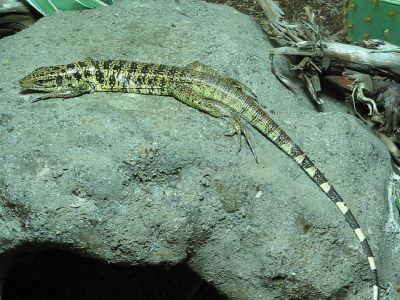 Teiidae: Whiptails.
Teiidae: Whiptails.
Range: Late Cretaceous to Recent, Asia (Cretaceous only), North, Central, & South America
Phylogeny: Teiioidea :Gymnophthalmidae + *
Characters: large rectangular scales that form distinct transverse rows ventrally and generally small dorsal granular scales, head scales that are separate from the skull bones, teeth are solidly set in the jaw, forked, snake-like tongue, well-developed limbs.
Comments: 230 extant species in ten genera; 75% of the species are included under Aspidoscelis and Cnemidophorus. This family includes both parthenogenic (periods of female-only "virgin birth" reproduction, hatching from unfertilised eggs) (e.g. Cnemidophorus and Aspidoscelis), and non-parthenogenic (e.g. Tupinambis, right) genera.
Image, references and Links: Wikipedia
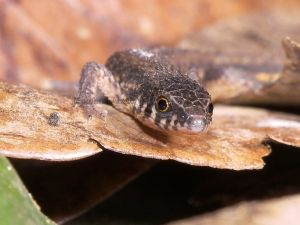 Gymnophthalmidae: Spectacled lizards.
Gymnophthalmidae: Spectacled lizards.
Range: No fossil record, known from the recent of Central and South America
Phylogeny: Teiioidea :Teiidae + *
Comments: generally small; tendency to reduce limbs. Unusually it is generally the hind limbs that are reduced or absent, rather than the front
Links and image: Wikipedia
Image: photo by Esteban Alzate, creative commons, Wikipedia
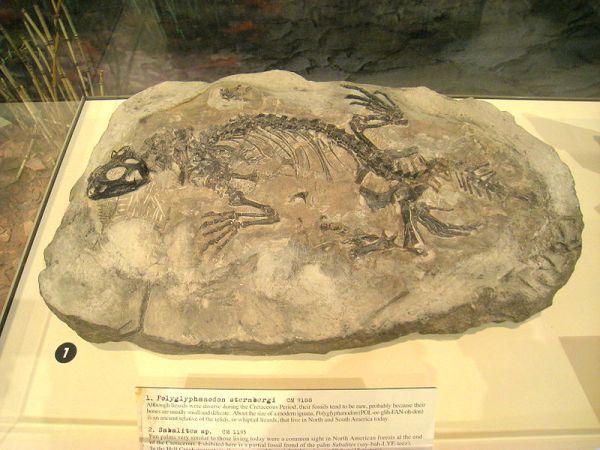 |
| Polyglyphanodon sternbergi, a Polyglyphanodontine lizard from the Maastrichtian of North America (), Carnegie Museum of Natural History. Photo by Daderot, Wikipedia |
Boreoteiioidea: Laurasian herbivorous scincomorphs.
Definition: The most recent common ancestor of the clade containing Chamops Marsh, 1892 and Prototeius Denton and O'Neil, 1995 and the clade containing Polyglyphanodon, Dicothodon, and Penetieus, and all of its descendents. (Nydam et al 2007)
Range: Late Cretaceous of Asia, Europe and North America
Phylogeny: Teiioiformes :Teiioidea + * : Adamisaurus + (Gilmoreteiidae + Polyglyphanodontinae+ Tuberocephalosaurs)
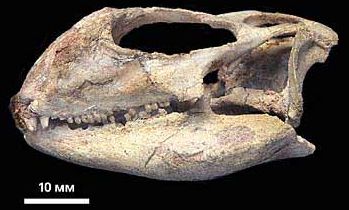 |
| The tuberocephalosaur Aprisaurus bidentatus, an advanced Boreoteiioid from the late Cretaceous of Mongolia, from Lizards in the era of dinosaurs, photo © VR Alifanov 2007 |
Characters: United by several synapomorphies, see Nydam et al 2007 for details. Polyglyphanodontidae of Conrad, 2008 p.103 is equiavlent, and supported by a number of synapomorphies.
Comments: The largest known radiation of herbivorous lizards, but also the only Late Cretaceous terrestrial lizard clade that did not survive the K-T extinction (Mo et al. 2009). The Teiioidea and Borioteiioidea seem to have diverged from a common ancestor by the Early Cretaceous, the Teiioidea entered South America (Gondwana) where they are currently represented by the Teiidae and Gymnophthalmidae, whereas Borioteiioidea may have had an East Asian origin and radiated throughout North America with subsequent dispersal to Asia and Europe; hence the etymology: boreas, north; in reference to the distribution of the included taxa (Nydam et al 2007). This asseblage includes up to four separate families; Adamisauridae, Gilmoreteiidae (= Macrocephalosauridae), Mongolochamopidae, and Polyglyphanodontidae, although some of these taxa may not stand up to cladistic analysis, amnd a number of other, mostly unnamed, clades can be constructed (Conrad, 2008 pp.102-104).
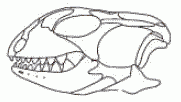 Adamisaurus: Adamisaurus magnidentatus Sulimski, 1972
Adamisaurus: Adamisaurus magnidentatus Sulimski, 1972
Range: Late Cretaceous of Mongolia (Djadokhta and Lower Nemegt)
Phylogeny: Boreoteiioidea :(Gilmoreteiidae + Polyglyphanodontinae + Tuberocephalosaurs) + *
Comments: a basal Boreoteiioid, with a short skull about 25 cm long, and teeth greatly increasing in size towards the rear of the jaws (Sulimski, 1972). The shape of the teeth are similar to those of some skinks and gekkos, but the structure of the lower jaw is more agamid (see link given below). Originally trentatively considered an Agamid, now known to be a Boreoteiioid (Mo et al. 2009)
Link: Nice photo here, Lizards in the era of dinosaurs, by VR Alifanov, 2007; an informative page about squamates of the Cretaceous of Mongolia (in Russian but translates reasonably well using Google translate)
Graphic: From Mo et al. 2009 from Estes 1983
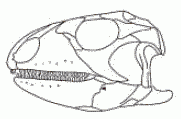 Polyglyphanodontinae: Polyglyphanodon, Peneteius, Dicothodon.
Polyglyphanodontinae: Polyglyphanodon, Peneteius, Dicothodon.
Range: Latest Cretaceous of Europe and North America
Phylogeny: Boreoteiioidea :Adamisaurus + (Gilmoreteiidae + Tuberocephalosaurs + *)
Characters: teeth with transversely-oriented crests
Comments: large-bodied scincomorphan lizards with herbivorous dentition. These may have been stout-bodied forms not unlike a heavyset skink, at least according to the reconstruction in Dixon 2008, see photo of skeleton). In animals such as Polyglyphanodon, as with other Boreoteiioids, the skull is strong and deep-sided, with broad cheek teeth that show that this animal fed on tough vegetation (Benton 2000 pp.239-40). The teeth are efficient chewing mechanisms, transversely-oriented (i.e. at right angles to the front and rear of the animal) , becoming larger in the back of the mouth, and interlock neatly with each other, and crowned with tiny, asymmetrical serrations. In contrast to the also herbivous Iguana, simply crops vegetation with scissors-like teeth at the front of the mouth, Polyglyphanodon could have sliced food with its entire tooth row, cutting food into smaller pieces and hence improving digestion, in contrast to most reptiles which simply swallow bites of food whole, although strangely the teeth do not show signs of wear, so it seems that food processing was minimal (Nydam and Cifelli, 2005). A related (Nydam et al 2007) but smaller form, Peneteius aquilonius had mammal-like multicuspid teeth, which indicated an insectivorous lifestyle (Nydam et al., 2000). (Thanks to Emile of The World we don't live in blog for the research, see link below for more)
Link: Of polyglyphanodonts and their teeth
Graphic: From Mo et al. 2009 from Estes 1983
MAK101104
  |
| Tuberocephalosaurus (top) and Tianyusaurus (bottom) |
Tuberocephalosaurs: Aprisaurus, Tianyusaurus, Tuberocephalosaurus
Range: Late Cretaceous of Central and East Asia
Phylogeny: Boreoteiioidea :Adamisaurus + (Gilmoreteiidae + Polyglyphanodontinae + *)
Comments: This unnamed clade includes both more typical forms such as the Mongolian Tuberocephalosaurus and abbarent types like the extraordinary Tianyusaurus of China. The latter, while sharings many traits with other large Asian boreoteiioids, has a shallower skull and lower jaw, with, unique among squamates, a complete lower temporal bar, resulting from an extensive quadrate–pterygoid overlap. This results in a situation like that of crocodiles and Sphenodon, with a more robust bite and akinetic skull. Extant herbivorous lizards (and no doubt boreoteiioids) stabilize their quadrates during powerful static biting by means of a combination of temporal ligaments and muscle action. Although a complete lower temporal bar provides a better mechanical solution, this does not explain why the skull of Tianyusaurus is so distinct from that of its relatives (Mo et al. 2009 p.5).
Graphics: From Mo et al. 2009, Tuberocephalosaurus redrawn from Alifanov, V. R. 2000
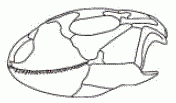 Gilmoreteiidae: (= Macrocephalosauridae).
Gilmoreteiidae: (= Macrocephalosauridae).
Range: Late Cretaceous of East Asia
Phylogeny: Boreoteiioidea :Adamisaurus + (Polyglyphanodontinae + Tuberocephalosaurs + *)
Comments: Unfortunately the exotic name Macrocephalosaurus (and hence "Macrocephalosauridae") is preoccupied (it was previously applied to a species of rhynchosaur) the group of Gobi lizards, and has to be replaced with the rather blander Gilmoreteiidae and Gilmoreteius (Langer, 1998)
Links: Gilmoreteius - basic text and good photos
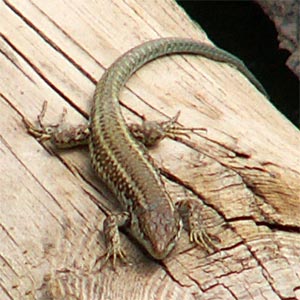 Lacertidae: wall lizards.
Lacertidae: wall lizards.
Range: Eocene to Recent of Europe, Africa, and Asia
Phylogeny: Lacertiformes :Teiioiformes + (Amphisbaena + *) (Hedges & Vidal 2009)
Comments: small to medium-sized lizards, usually insectivorous, slender bodies and long tails, highly varied colours. Scales on the head large, often becoming osteoderms, small and granular on the back, and rectangular on the underside. Most species are sexually dimorphic, but a few are parthenogenic. Sometimes called "true lizards" (presumably as opposed to skinks, gekkos, monitors, etc) MAK101104
Links (and image): Wikipedia
Range: fr upK of Africa, Eur, NAm & SAm.
Phylogeny: Scleroglossa :::Gekkota + *. (morphology Lee 1998) or Lacertiformes/Laterata :Teiioiformes + (Lacertidae + *) (molecular phylogeny Hedges & Vidal 2009)
Characters: 10-70 cm; rigid, consolidated skull; single median tooth on premaxilla; eyes reduced; postorbital skull elongate for large muscle attachment; brain completely surrounded by frontals; tail short; pelvic & pectoral girdles reduced or absent; most legless; annuli around body frees integument from trunk & allows concertina motion; right lung reduced; insectivorous; specialized to level of subsoil (skull for digging v. hunting). ATW010721
Comments: A specialised group with no clear morphological relationships, beyond basically Scleroglossan affinities. Variously included with gekkos and dibamids (Lee 1998), Scincomorpha (Conrad, 2008), or Lacertiformes/Laterata (Hedges & Vidal 2009). MAK101106
Links: Amphisbaenidae; xrefer - amphisbaena; Herpetology 1999 - October. ATW010721.
| Page Back | Unit Home | Page Top | Page Next |
checked ATW050706